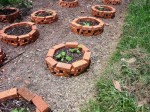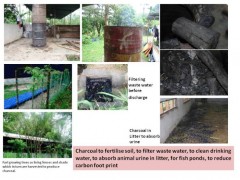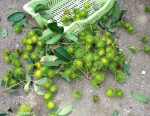Aug 23, 2009
Preventive Measures for Flu - Revisited
In 2005 we posted on preventive measures one can take against Avian Flu. The strategies are still valid against A(H1N1). To read the post, click here:
http://dqfarm.blogspirit.com/archive/2005/09/26/preventiv... .
We no longer teach Qi Gong (one of the strategies), so if you are keen, you can join a local class in your neighbourhood.
Also, there have been numerous reports that TCM (Traditional Chinese Medicine) preparations for flu are effective against A(H1N1). Visit a reputable centre such as Tung Shin.
09:13 Posted in Blog | Permalink | Comments (0) | Tags: h1n1, flu prevention
Aug 21, 2009
A Spot Of Darkness
I have this thing about Darkness. So we decided to build a spot of darkness in a corner of the farm; a spot dedicated to dark colored plants. Plants with dark leaves, dark flowers, dark tubers.
The plants will be grown in a raised bed with a Permaculture key-hole design.
Lay out the design with the key-hole (used for walking when tending the garden)
Build up the wall; how high depends on how deep-rooted the plants are. (These are left-over clay bricks from the walit house).

Put in the planting material; here, dead leaves, some very old broken down chicken manure, some soil etc.
Then add in the compost and the plants.
Then mulch it.
Here we have only completed planting just one corner while we hunt for more dark plants. We planted some aroids from the jungle, such as this (haven't got the name yet. Click for close-up). :
And a Tacca Chantrieri from the jungle, which flower is black (Click on photo for close-up) :
Photo of the Tacca flower from here
Once the garden is matured, perhaps we can sip dark pu erh tea and savour it with a melancholic Stratovarius playing in the background.
12:04 Posted in Blog | Permalink | Comments (0) | Tags: raised beds, key hole garden, permaculture, dark colored plants.
Aug 17, 2009
Raised Beds – More Efficient?
We were quite happy with our 71kg of pumpkins from the trial 35ft x 10ft 'no-dig' patch.
From that first pilot, we have decided it may be more efficient all-round to grow pumpkins in raised-beds. Here's a couple of pictures of our pumpkin raised-bed patch:
Of course we are not advocating using clay bricks for the raised-beds. We happened to have some left over from the walit house.
You can also use bamboo as the next picture illustrates:
It will be interesting to know the overall cost-effectiveness of this 'raised-bed' method for growing pumpkins in terms of energy and effort used, production, etc.
15:43 Posted in Permaculture | Permalink | Comments (0) | Tags: raised beds, pumpkins, permaculture
Aug 10, 2009
Caviar of the East - Edible Bird's Nest
The swiftlets of the species, Aerodramus fuciphagus and Aerodramus maximus produce edible nests called the caviar of the East, primarily because of the high price.
The swiftlets come down from the forest reserve adjoining our farm to feast on the many insects that the farm is home to. We are building a 3 storey building for the birds to harvest their nests in a sustainable manner.
Barely three weeks after we started work, the building is now on its final third level. And today while the outside temperature was hovering between 30 to 34 celcius, the inside was a constant 24 celcius, the ideal temperature for the birds. The wonders modern construction methods can do!
The key to successful swiftlet rearing is stability of temperature throughout the day and night. We are off to a good start.
The last floor. Click on pic for a close-up look.
Update September 13th, 2009 :
click to enlarge
September 13th, almost there. The fasting month has delayed things somewhat as some of the workers went back to their home villages. Hopefully, after Hari Raya Aidilfitri we can start calling the birds to come to their new home.
10:54 Posted in Blog | Permalink | Comments (2) | Tags: walit, swiftlets, aerodramus fuciphagus, aerodramus maximus
Jul 27, 2009
Charcoal for Sustainability
We produce our own charcoal for multiple use at the farm: to bury carbon as part of the requirement for responsible animal husbandry, to use it to absorb urine and reduce ammonia in litter, to act as a filter in aquaculture, to clean waste water before discharging into rivers, to use as fertiliser for our fruits and vegetables, and to use as a more efficient source of fuel.
We plant fast growing trees such as acacia mangium and gliricidia septium as a renewal source of wood for charcoal production. The fast growing trees are planted where ever we have chickens, even right next to the coops or rebans.
In the fields, they not only convert CO2 to carbon, but also absorb nutrients from the chicken dung.
In this way, we try to reduce our carbon footprint, which should be a required part (and parcel) of the process of raising animals for food.
Click on the picture below for enlarged view:
09:45 Posted in Sustainable Farming | Permalink | Comments (1) | Tags: biochar, retort, sustainable farming
Jul 25, 2009
Grey Water Treatment; mini wetlands
13:23 Posted in Sustainable Farming | Permalink | Comments (4) | Tags: grey water, wetlands, permaculture water treatment
Jul 24, 2009
Birds at the Farm
The farm at one time was a zoo of exotic birds. We developed all black cemani type chickens, hybrids between guinea fowl and chickens, chickens that weigh in at less than 250 grams fully grown and various other exotics. Visit the album of some of the birds by clicking the link below. We will add as we go along.
http://dqfarm.blogspirit.com/album/birds-at-the-farm/
14:57 Posted in Blog | Permalink | Comments (0)
Jul 23, 2009
Nature Q-Farming And Durians
This year, the damage to the durians from fungus is less than 5%. A couple of years back, the damage was 30%. The supervisor at that time could not learn how to do the qi-compost right and we did not use the Teh Qi. His breathing was all wrong.
Ali, my current supervisor is a picture of amazement and just cannot understand what's happening.
He keeps on asking, how come the Teh Qi (Qi Tea) can do this? What is inside the Teh Qi that can reduce the fungal attacks by so much?
Ah Tick, the man who actually takes care of the durians for us on a daily basis says that the degree of damage is the same as those durian farms that use chemicals RIGHT UP TO THE LAST MINUTE OF HARVEST. He himself owns 8 acres of durians. He says, because of the low prices, farmers must ensure that every fruit survives, so they spray until the durian drops. So if you buy conventionally grown durians, make sure you wash your hands after opening the durians before taking hold of the pips to eat.
The Teh Qi is unique, it provides the full compendium of microbes that plants need PLUS it vibrates with energy that gives plants that little extra edge between infested with fungus or being disease free, ceteris paribus.
The next problem Ali and Ah Tick wants Nature Q-Farming to solve is the issue of uneven ripening, especially the D24 variety. This is a problem with unknown causes that farms from Thailand to Australia face. I told them, it's not a problem. Come next season, Nature Q-Farming will reduce that problem by 70%, I promised.
12:32 Posted in Nature Farming | Permalink | Comments (0) | Tags: qi gong, chi kung, nature farming, durians
Jul 16, 2009
Fruiting Season...
It's fruiting season and here are some of the fruits:
Dragon fruit plant and the fruits.
Here's a macro close-up of the flower (click for enlarged photo) :
While half of the pitaya farms in Malaysia are decimated by a fungal problem, ours are free from disease with regular spraying of Teh Qi.
All manners of hard-to-find Musa varieties.
Other fruits ripening include mangosteen, nangka and cempedak.
We estimate our production this year to be 50 metric tonnes, all grown with our own farm-made compost.
17:00 Posted in Blog | Permalink | Comments (2) | Tags: dragon fruit, jackfruit, cempadak, durians
Jul 01, 2009
First Pumpkin
Harvested our first pumpkin today. It is actually a variety of Japanese squash, weighing in at 2kg. We saw one sold at Hock Choon for RM10.50 per kg.
Barely 6 hours after harvesting it, it is changing color nicely to a dark golden-brown.
Can't wait for the aging period to be over to taste it.
20:56 Posted in Sustainable Farming | Permalink | Comments (0) | Tags: kabocha, squash, japanese pumpkin, japanese kabocha, organic pumpkin, organic squash



































